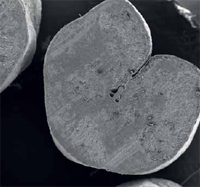Gelatinised cereals in piglet feeds for easy digestion

In Europe, piglets are generally weaned at three to four weeks. Stress, infections and a low feed intake can give rise to problems during this period. Puffed cereals are completely gelatinised and easy to digest. This ensures fewer health problems and improves the absorption of nutrients.
By Gerard van der Hoek and Bram Gunter, Meneba, the Netherlands
Weaning involves an abrupt switch from milk to solid feed. The supply of nutrients changes radically. Carbohydrates replace fat as the main energy source, and there is a shift from animal to vegetable protein. Piglets often have difficulty coping with this sudden switch because it takes time for the enzyme production in their digestive system to adapt to the new situation. In its native form, the starch is difficult to digest in the small intestine. A large amount of undigested starch passes into the large intestine where the intestinal bacteria cause explosive fermentation.
For better starch utilisation, starch needs to be mechanically or thermally gelatinised. The thermal treatment also affects the viscosity of the mass in the stomach and the intestine and therefore nutrient intake. For thermal gelatinisation of starch in cereals, Dutch food and feed ingredients manufacturer Meneba, headquartered in Rotterdam, developed its so-called Presco process. According to the company, this process has positive benefits over other techniques such as steam flaking, micronising, expanding and extruding.
The gelatinisation process
During this specific process, which produces unprecedented starch gelatinisation, cereals are treated under high pressure (20-25 bar) with overheated steam for 15 to 30 seconds. By suddenly reducing the pressure, the grains expand rapidly and destroy the crystal structure of the starch entirely. Microscopic images of untreated wheat and wheat treated with this process reveal the effect of the treatment as can be seen in the illustrations.
The untreated wheat contains whole, undamaged starch granules. After treatment, the starch granules are fully gelatinised and no retrograde effect occurs. The process has an impact on the functionality in terms of degree of gelatinisation, ileal digestibility, faecal digestibility and viscosity which gives the treated wheat useful characteristics to be used in piglet feed. Using this specific treatment, the gelatinising degree in maize can be up to 75%, in wheat it can reach 80% – compared to 25% and 30% respectively in case no treatment is used.
Ileal digestibility
More important than the degree of gelatinisation is digestibility. In vitro tests were performed at the independent research centre Schothorst Feed Research to determine the ileal digestibility of untreated and treated maize and wheat. The in vitro tests were performed with a validated pig model, which provides a reliable forecast of in vivo digestibility.
The gelatisation process was shown to have a positive effect on this parameter, both in wheat and maize. For comparison purposes, the digestibility of other starch gelatinisation techniques was also determined. The novel gelatinising approach produces the highest ileal digestibility in both starch and organic matter.
Faecal digestibility
In addition to ileal digestibility, the faecal digestibility of the organic matter and the starch was measured at in vitro level. The differences are much smaller at faecal level, but this phenomenon is well-known in other gelatinisation techniques too. This is caused by microbial fermentation in the large intestine: anything that remains undigested in the small intestine ferments in the large intestine. Too much fermentation in the large intestine is harmful. That is why high ileal digestion, which this type of gelatinisation process promotes, is beneficial to piglets.
Viscosity
Because of their high degree of gelatinisation, both the treated maize and wheat products generate high viscosity in the piglet stomachs. Piglet feed remains in the stomach for longer, enabling the piglet’s protein-splitting enzymes to digest the protein in the feed more effectively, resulting in higher ileal amino acid digestion.
One positive consequence of this is that there is less undigested protein, which can act as a substrate for pathogenic micro-organisms in the piglet’s gut. After the feed has remained in the stomach for longer, it passes regularly into the small intestine. The high degree of gelatinisation means that the starch in treated products is quickly broken down by the enzymes present in the digestive juices.
Besides the high ileal digestibility of the organic matter and starch, this results in a rapid reduction in the viscosity of the mass in the small intestine, simplifying the transport of nutrients to the intestinal wall. In addition, an optimum nutrient uptake is ensured. This combination of effects leads to faster piglet growth and a better health status.
| Structure of untreated wheat: The starch granules are completely intact. | Structure of treated wheat: The starch granules are completely gelatinised. |
Source: Pig progress magazine Volume 26. No. 10











